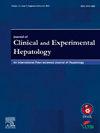摄入异物引起的肝脓肿:临床特征和诊断挑战——对当前报告病例的系统回顾
IF 3.2
Q2 GASTROENTEROLOGY & HEPATOLOGY
Journal of Clinical and Experimental Hepatology
Pub Date : 2025-04-29
DOI:10.1016/j.jceh.2025.102586
引用次数: 0
摘要
由摄入异物引起的肝脓肿是一种罕见但可能危及生命的疾病,通常导致诊断延误和并发症。本系统综述总结了报告病例的临床特征、诊断方法和结果。方法检索电子数据库(MEDLINE, OVID, EMBASE),检索截至2024年12月发表的病例报告和病例系列,描述脓肿内可见异物的肝脓肿。我们排除了在脓肿内无论是放射学上还是手术上都没有视觉上证实异物的病例。提取了人口统计学、临床表现、影像学、微生物学、治疗和结果方面的数据。采用描述性统计对数据进行汇总。结果纳入167项研究(178例)。平均年龄56岁(62%为男性)。常见的症状包括腹痛(83%)和发烧(78%)。鱼骨是最常见的异物(51%)。最常见的分离生物是链球菌。大多数需要抗生素和手术治疗。描述性的结果提出了关于穿孔部位以及详细的病例记录。结论临床医生应注意由摄入异物引起的肝脓肿,特别是在排除了其他感染源、x线片上看不到异物、甚至没有摄入异物史的情况下。放射学证实异物对诊断至关重要。本文章由计算机程序翻译,如有差异,请以英文原文为准。

Hepatic Abscess from Ingested Foreign Body: Clinical Features and Diagnostic Challenges—A Systematic Review of Current Reported Cases
Introduction
Hepatic abscess resulting from ingested foreign bodies is a rare but potentially life-threatening condition, often leading to delayed diagnosis and complications. This systematic review summarizes the clinical characteristics, diagnostic approaches, and outcomes of reported cases.
Method
We searched electronic databases (MEDLINE, OVID, EMBASE) for case reports and case series published through December 2024, describing hepatic abscesses with a visualized foreign body within the abscess. We excluded cases where the foreign body was not confirmed visually within the abscess either radiologically or surgically. Data on demographics, clinical presentation, imaging, microbiology, treatment, and outcomes were extracted. Descriptive statistics were used to summarize the data.
Results
We included 167 studies (178 cases). The mean age was 56 years (62% male). The common presenting symptoms included abdominal pain (83%) and fever (78%). Fishbone was the most common foreign body (51%). The most commonly isolated organisms were Streptococcus species. The majority required antibiotics and surgery. Descriptive results are presented regarding the perforation sites as well as details of case record.
Conclusion
Clinicians should be aware of hepatic abscesses from ingested foreign bodies, particularly if other sources of infection have been excluded and foreign bodies are not visible on the radiography or even without a history of foreign body ingestion. Radiological confirmation of a foreign body is critical for diagnosis.
求助全文
通过发布文献求助,成功后即可免费获取论文全文。
去求助
来源期刊

Journal of Clinical and Experimental Hepatology
GASTROENTEROLOGY & HEPATOLOGY-
CiteScore
4.90
自引率
16.70%
发文量
537
审稿时长
64 days
 求助内容:
求助内容: 应助结果提醒方式:
应助结果提醒方式:


